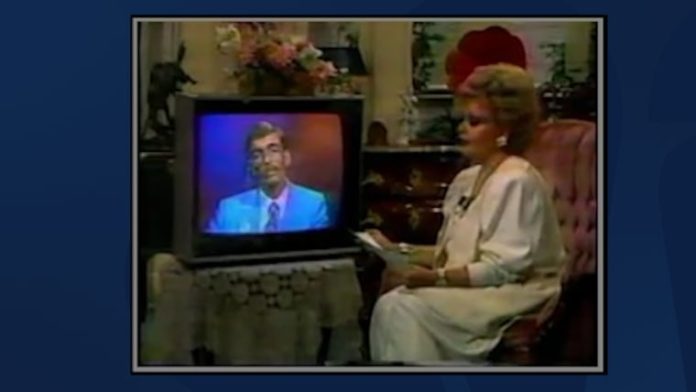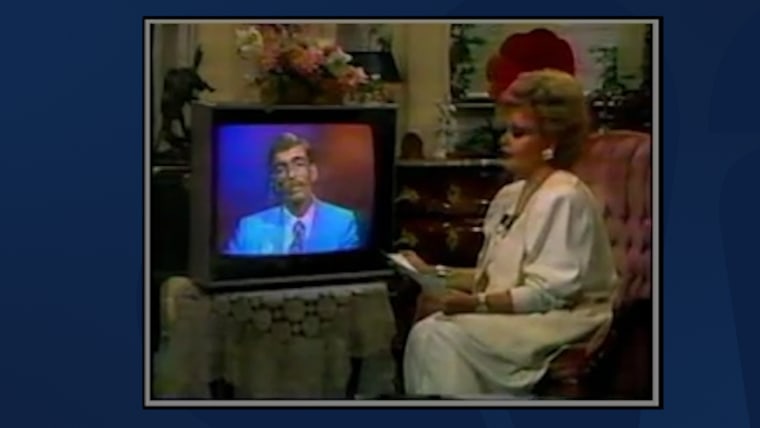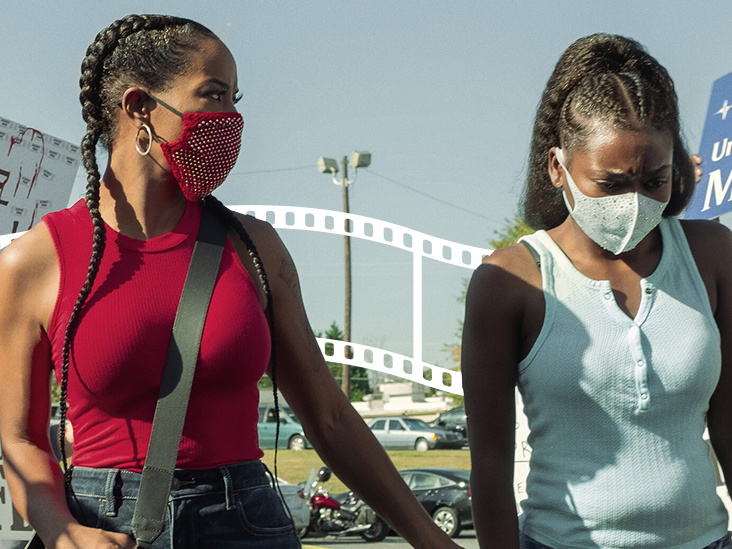On Nov. 15, 1985, just two months after President Ronald Reagan finally uttered the word “AIDS” publicly, the televangelist Tammy Faye Bakker did something considered bold and fearless at the time: She interviewed a gay man living with HIV on live television and treated him with compassion.
“How sad that we as Christians — who are to be the salt of the earth, we who are supposed to be able to love everyone — are afraid so badly of an AIDS patient that we will not go up and put our arm around them and tell them that we care,” Bakker said tearfully during her 24-minute interview with Steve Pieters.
The conversation aired during “Tammy’s House Party” on the Praise the Lord network, a channel that reached 20 million viewers across dozens of countries at the height of its popularity. It is thought to be the first time a televangelist ever talked to someone living with AIDS or HIV on television, and the in-depth interview (too in-depth for some viewers) became an important milestone in AIDS and LGBTQ history.
While Bakker, who died of cancer in 2007 at age 65, has a complicated legacy, muddied by her first husband Jim Bakker’s fraud conviction, her record on gay rights, particularly the empathy she showed those living with HIV and AIDS, has remained clear and was radical for its time.
Bakker’s watershed conversation with Pieters took place more than 35 years ago, but it has been thrust back in the spotlight thanks to the new film “The Eyes of Tammy Faye,” starring the Oscar-nominated actor Jessica Chastain in the titular role. Based on the RuPaul-narrated 2000 cult documentary of the same name, the film, which debuts in theaters Friday, prominently features this groundbreaking interview.
“When I saw the documentary and I saw that scene — that incredible moment between Steve Pieters and Tammy Faye — I knew how important it was, because my knowledge of Tammy was just what the media had fed me, this sensationalized version that focused on the drama,” Chastain, who also was executive producer of the film, told NBC News from the Toronto International Film Festival. “That is not really the true story of who she was, and that blew me away.”
Chastain acquired the rights to Bakker’s story nearly a decade ago and has been working to bring the film to the big screen ever since.
“For me, that interview was the reason I had to make the film; it was the most important scene,” she said. “Steve Pieters is phenomenal, all of his answers were so loving and beautiful, and Tammy Faye, she had all these little naive questions. I’m convinced they saved lives with that interview, because many in the conservative evangelical world were disowning their children who are coming out to them.
When Bakker learned, during that interview, that Pieters’ parents accepted him when he came out to them, she got visibly emotional.
“Thank God for a mom and dad who will stand with a young person,” she said. “They’re still your boy, they’re still your girl, no matter what happens in their life, and I think it’s so important that we as mom and dads love through anything, and that’s the way with Jesus, you know. Jesus loves us through anything.”
To which Pieters responded: “Jesus loves me just the way I am, I really believe. Jesus loves the way I love.”
The empathy of a survivor
While Bakker won’t get to see herself portrayed on the big screen, Pieters — who was given eight months to live in 1984 — is still alive today. A Los Angeles resident and now 69, Pieters said he is happy to see his interview with Bakker portrayed in the film and reaching a new generation that may not be aware of the horror and stigma those living with HIV and AIDS faced in the early years of the epidemic.
“I don’t really know why I’ve survived what killed so many other people,” Pieters told NBC News. “I was legally blind for a time, I was paralyzed on the left side of my body and my adrenal glands blew out. It very nearly killed me a couple of times, but they pulled me back from the brink, and I am here to tell the tale. Is it a miracle? Is it an anomaly? I don’t know.”
Pieters came “roaring out of the closet” in the 1970s and became an activist and pastor in a gay-affirming church, he said. In 1982, he got sick with what was then known as GRID, or gay-related immunodeficiency. It would later be renamed AIDS, or acquired immunodeficiency syndrome.
“I was terribly sick over the next few years, finally diagnosed with stage four lymphoma and Kaposi’s sarcoma in April of ‘84 ,” he said. “And I managed to survive that prognosis.”
“My doctor, God bless her, told me when I was first diagnosed terminal that not everybody was going to die from AIDS. She said, ‘If there is one in a million survivors, why not believe you’re that one in a million?’”
In 1985, Pieters said, he was the first patient to be given one of the first drugs scientists ever tried against HIV, an antiviral agent called suramin. About six weeks into the treatment, he said the cancers ignited by the virus were in complete remission and disappeared. The drug, however, was extremely toxic, making him sick. Every other person in the trial died but one, he said.
Like Pieters, Bakker considered herself a survivor, and that survivor status is what connected her to so many people, according to those who knew her. She even wrote a book titled “I Will Survive … And You Will, Too” in 2003 that recounted her various struggles, including her divorce, her first bout with cancer and how she coped with addiction and depression.
And like many people who survived the AIDS epidemic of the 1980s, Pieters said he has had to reconcile complex feelings about being a survivor.
“What I discovered about that over the years is that I can’t be fully alive if I allow the survivor’s guilt to rule my life,” he said. “I have to find the joy in life, each and every day.”
“None of us have any guarantees about tomorrow,” he added. “So I’m here now feeling joy in spite of whatever may be going on in my life or in the world, and that to me is what’s really important. Joy, I’ve discovered, is not the absence of suffering, but the presence of faith and hope and love, and I have tried to live that.”
‘The fearlessness of a drag queen’
It was during that deadly drug trial that Pieters sat down for an interview with Bakker via satellite from California. Bakker was broadcasting from the Praise the Lord studios in Charlotte, North Carolina. She claimed during their interview the reason Pieters wasn’t able to travel to the studio was because of his chemotherapy treatments, but Pieters said there was more to the story.
“I later found out that — while Jim and Tammy would have been very hospitable towards me — they were afraid that [their employees] might not treat me well, and that indeed the camera crew might not work if I was in the studio,” he said. “So I think it was a combination of them wanting to be careful for my health, but also to make sure that I wasn’t treated badly by other employees.”
Some critics of the interview have pointed to the invasiveness and even offensiveness of Bakker’s questions — which included queries about Pieters’ sex life, if gays could turn their kids straight and why Pieters had “no hope … to be straight” — but Pieters said even though some of her questions left him speechless, he was happy she asked them.
“I’ve had a number of people who’ve seen the interview tell me over the years, ‘Well, she asked a lot of really kind of silly questions, especially about being gay,’” Pieters said. “But they were the right questions for the audience, and I knew that at the time — even though I was kind of flabbergasted when she asked me if I’ve ever had a sexual experience with a woman. But, you know, they were the right questions for her audience, and I took it as an opportunity to educate them.”
Pieters also said he believes her questions about his sexuality had a more personal reason as well. “It has been said that in questioning me so closely about why I had to be gay, she was grappling with issues of her own marriage,” he said.
In the late 1980s, fellow televangelist Jerry Falwell accused Jim Bakker of having sexual relationships with other men, including a Praise the Lord official, who revealed his alleged relationship with Bakker to a federal grand jury convened to determine if ministry money was paid for sexual favors. Jim Bakker denied those allegations but was convicted of 28 counts of fraud and conspiracy in 1989 and sentenced to 45 years in prison. He was paroled in 1994 after serving just under five years. He has been married to his second wife for over two decades.
Whatever Bakker’s intentions may have been, her interview with Pieters shook the Christian world and was seen as an act of defiance against the church and conservative political values.
“It was powerful and it was radical, and she got in a lot of trouble for it,” Pieters said of the backlash.
Bakker’s daughter, Tammy Sue Bakker, also uses the word “radical” when describing her mother, particularly the acceptance she said her mother showed to people who were ostracized by other high-profile Christians at the time.
“I was not raised with judgment; that just was not in our house,” she told NBC News in her first interview in 17 years. “It was always a beautiful thing, and it was always meaningful as far as that goes and just accepting. My best friend in high school was gay and that was the school we had at Heritage. Everybody was kind and loving to him, even at our church.”
Tammy Sue Bakker was 15 when her mother interviewed Pieters, but she said she remembers it clearly.
“I knew that when mother did the interview, that it was groundbreaking and that people were going to be angry, because Christians didn’t understand it,” she said. “I was proud of her for doing it.”
“Her love was on display that day, and she was not ashamed of it,” she added. “She didn’t have that fear of what people were going to think. She wore makeup, she wore her wigs, she had her big boobs, she wore her crazy clothes and her big earrings and sang the way she sang. She had a book called ‘I Gotta Be Me,’ and that’s her. That’s the way she was.”
In the 2000 documentary — which premiered when federally recognized same-sex marriage was just a pipe dream and gay sex was still criminalized in many states across the country — Tammy Faye Bakker was asked about her attitude toward gay rights. She notably replied, “We’re all just people made out of the same old dirt, and God didn’t make any junk.” It’s also a line used in the Chastain film.
Bakker’s boldness and her refusal to conform was something that struck Chastain — and inspired her to draw a perhaps fitting comparison, as Bakker evolved into a gay icon of sorts and even served as inspiration for gender-bending performers.
“She had the fearlessness of a drag queen,” Chastain said. “There was something about her, people talk about drag like a mask or her makeup is a mask, and for me, I saw it as a way that she was expressing how she felt inside. It wasn’t a mask; she wasn’t hiding — it was truthful. She was being creative, she was being artistic. It was a beautiful thing about her.”









